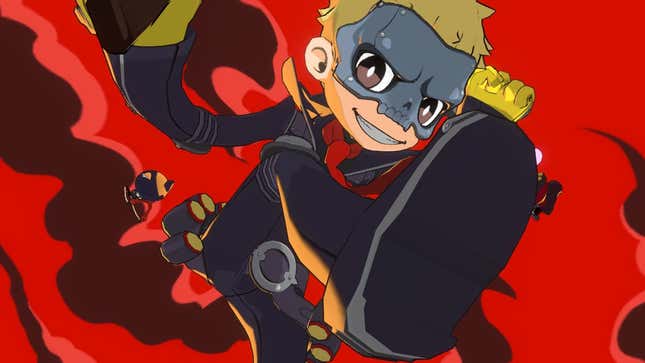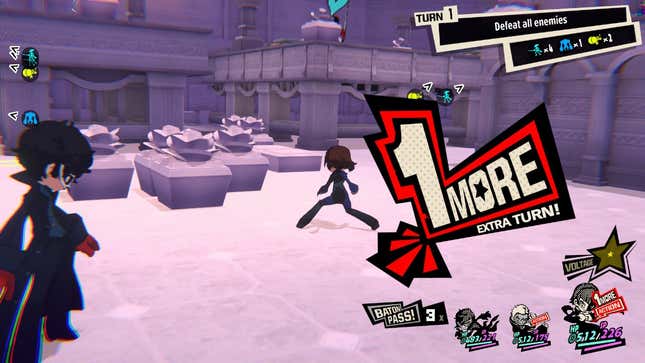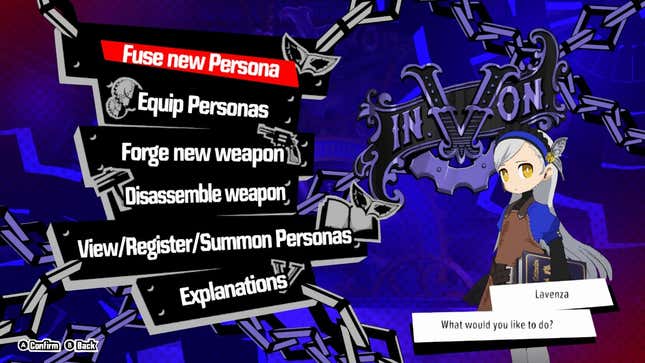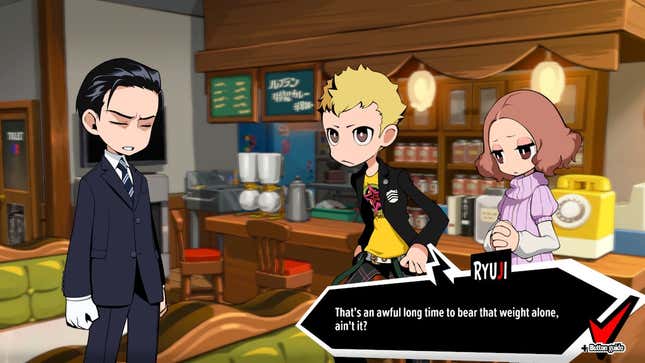
Persona 5 Tactica riffs on a lot of the original game’s mechanics and retools them for a tactics-based grid. At first, it’s pretty simplistic, and the opening chapter painstakingly tutorializes all these mechanics with the most straightforward use cases. But as I played through the Phantom Thieves’ latest journey, I actually found its spin on turn-based systems pretty rewarding. Here are a few tips for making your way through Persona 5 Tactica.
The All-Out Attack is still your go-to strategy
Much like most Persona games, the All-Out Attack is the core of nearly every play you’ll make in a fight. Instead of having to knock down every enemy on the field with a critical hit like in P5, you only have to strike one down and have your team in a triangle formation across the map in Tactica.
This spin-off is pretty liberal with what it considers a triangle, and after you critically damage an enemy, you have another chance to move characters around and make that formation. The trick here is that you can swap between both the critical hitter and their team before activating an All-Out Attack. If you carefully position your three party members and spread them out, you can get near map-spanning attacks and only use one unit’s turn to do so. Movement on its own doesn’t take up a turn, so if you’re trying to set up an All-Out Attack, spread that triangle out as far as you can and catch as many enemies in the blast as possible.
The 1 More mechanic is for movement too
Speaking of critical hits, when you get your 1 More turn, your character will also be able to move a few more spaces in addition to attacking. Tactica’s fights are all about positioning and movement, and utilizing 1 More to move a few extra squares is invaluable to making the most of your turns. It lets you set up good All-Out Attacks andfind better cover to ensure you don’t get hit with a critical attack yourself.
Critical hits aren’t determined by chance
In most turn-based RPGs, critical hits are determined by chance or abilities. Persona 5 Tactica is all based on a three-tiered cover system. Both the Phantom Thieves and the enemies they face in the Metaverse can take cover on a map to avoid attacks, or at least lessen their impact. Some cover can entirely negate damage, and it’s visually communicated by objects being taller than a character. There’s a second tier of cover that characters can hide behind, but they’re waist-high and don’t conceal a character entirely. If you’re on the receiving end of an attack while in this cover, your character will take less damage than if they’re out in the open, but won’t get out of a scrap unscathed.
Much of your strategy in Tactica funnels into getting enemies out of cover and striking them with any attack to score a critical hit. In Tactica, pulling this off is much more predictable than in Persona 5 proper.
Fast-forward through enemy turns
During some of the less strenuous fights, Tactica makes you watch some pretty mundane plays from low-level enemies. It took me a chunk of the game to realize that you can actually fast-forward through enemy turns. If you’re trying to get to the good stuff, you can speed up your foes by pressing R on your Joy-Con, or the equivalent on the system you’re playing on.
Don’t be too precious about Voltage
Each Phantom Thief has a powerful special move trigged by Voltage, a meter charged up with each turn. Ryuji’s drops a powerful attack that spans a straight line across the map, Joker can get free critical hits in a small area, and Morgana can blow away enemies with an AOE attack that can set up multiple critical attacks. I was hesitant to use these abilities at the first opportunity because these are such high-impact moves, but I soon learned that Voltage charges up quickly. If you’re using them early and often, you can set off several of these moves over the course of the fight.
Read more: Persona 5 Tactica Tries To Make Up For The Series’ Homophobia
Buy Persona 5 Tactica: Amazon | Best Buy | GameStop

Cover direction matters less than you’d think
One of the weird quirks of Persona 5 Tactica’s cover system is that it doesn’t always matter if you’re attacked from a clear line of sight. As long as you are in cover, you get some of the perks of the position. So if your unit has their back against a wall but get shot by someone who can clearly see you, they won’t take full damage and it won’t count as a critical hit. So while you’re about to end a turn, whether that be with an attack or just by getting in a different position, try to have your character next to a wall or obstacle. Even if it doesn’t obscure an enemy’s vision, you’ll get some benefit.
Elemental weaknesses are gone
One of the major changes in Tactica is that elemental weaknesses are no longer a factor. That means Air, Electric, and Fire attacks have an inherent secondary effect. Air abilities blow enemies away, Psychic attacks draw them in close, and Electric ones zap enemies in place. The strategy comes from situational awareness about when to use abilities and how they will help you set up All-Out Attacks.
For example, some enemies will counterattack every time you strike them by lunging across the map. You can see their range before you attack them, but if you’re using a Psychic ability that draws them toward you, you’re increasing the chance of getting dunked on. Conversely, freezing them with an Ice attack will hold them in place, allowing you to follow up with another attack, possibly from a better position out of their reach. It adds a whole new layer to team composition, and means you don’t need to prioritize specific characters solely for their elemental affinities.
Use Sub-Personas that compliment a character’s base strengths
The tweaked magic system gives you a lot of room to experiment with strategies that pair spells together. You can execute some cool plays with multiple characters, but Sub-Personas give you an opportunity to create those synergies with just one character.
The optimal way to use this is to give characters a new kind of magic, rather than doubling down. Try to find abilities that complement a unit’s established play style. Ryuji wields a shotgun as his firearm, so his weapon doesn’t have the range of other characters. However, if you give him a Psychic-based Sub-Persona, he can draw in enemies closer and have a better range for a follow-up. So while Sub-Personas are a lot of resource management, they can come in handy if you use them wisely. But on that note…

The loot outpaces Persona fusion
I played Persona 5 Tactica on its standard difficulty, so this might not apply if you’re playing on more challenging settings. You manage your Sub-Personas in the Velvet Room by fusing them to create stronger ones. But in my playthrough, I found it much easier to just use the new Personas I gained through completing battles, as they kept up with the pace of the game pretty well in terms of giving me more powerful spells to handle late-game fights. So while the sickest of sickos may want to fuse Persona to get some of the most powerful ones in the game, you’re probably fine just sticking to the ones you pick up along the way.
Persona 5 Tactica isn’t structured around the grind
This, again, might not apply to those who are playing on higher difficulties, but Persona 5 Tactica scales pretty well for those who are just playing through combat encounters once. This isn’t a grind-based RPG, it’s all about strategy, puzzle-solving, and situational awareness. The game is based around tactical play, rather than numbers being too low or high. So while you can replay old fights, don’t worry about feeling like your characters aren’t going to be powerful enough.

Quests are a great way to master mechanics
While you don’t need to worry about grinding, it is worth going out of your way to play the optional fights and quests Persona 5 Tactica has between story missions. In the Hideout menu, you can pick from Quests you’ll unlock as you make story progress. These are bite-sized side stories that are more puzzles meant to test your understanding of mechanics. One example requires you to get one character to a point on a map in one turn. The trick is to use two of your teammates to set up 1 Mores that the third unit can use to extend their turn long enough to reach the other side of the map. There’s some pretty clever stuff here that helped me grasp how to play Tactica well, and it’s a great way to expand your strategies.
Talk to your team and you’ll get rewards
If you’re playing a Persona game, you know the best part is the social aspects where you get to know your team. Tactica doesn’t have the series’ signature Social Link feature where you talk to folks one-on-one, but you can have team-wide conversations where you talk about their latest adventures. These scenes are fun, albeit very focused on newcomers Erina and Toshiro, and they also give you some skill tree points for seeing them through. So be sure to check in with your group every chance you get in Leblanc by clicking on the Talk menu.